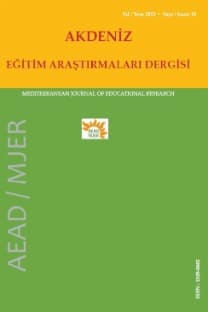Pre-service physics teachers' understanding of the photoelectric effect: A qualitative study
Bu çalışmanın amacı fotoelektrik olayda fotonlar tarafından sökülen elektronlara ait I=f(V) grafiğinin öğrenciler tarafından yorumlanmasını araştırmaktır. Çalışma Ankara ve İzmir’de bulunan iki farklı devlet üniversitesinde öğrenim gören fizik öğretmen adaylarıyla gerçekleştirilmiştir. Toplam 35 öğretmen adayı çalışmada yer almıştır. Açık uçlu sorular yardımıyla toplanan veriler içerik analizi yöntemi kullanılarak analiz edilmiştir. Araştırma sonunda, öğrencilerin fotoelektrik olay kavramlarına yönelik öğrenme zorluklarının olduğu tespit edilmiştir.
Fizik öğretmen adaylarının fotoelektrik olayı anlamaları: Nitel çalışma
The aim of this study was to investigate the students’ interpretation of I=f(V) graph and electron’s energy emitted by the photons on the photoelectric effect. The study was done at two different state universities’ physics education department with pre-service physics students in Ankara and Izmir. A total of 35 participants took part in this study. The data collected by the open-ended questions were analyzed by using content analysis method. The results of the study revealed that there were students’ learning difficulties regarding concepts of the photoelectric effect.
___
- Aubrecht, G. (2003). Do students have any quantum-related ideas prior to study in college classes? In Teaching Physics for the Future, ed. Moltô, E. Havana, Cuba: Proceedings of the VIII IACPE, 574-580.
- Bernstein,J., Fishbane, P.M. & Gasiorowicz, S.G. (2000). Modern physics.(1th ed.), Prentice-Hall,USA.
- Büyüköztürk, Ş., Kılıç Çakmak, E., Akgün, Ö. E., Karadeniz, Ş. & Demirel, F. (2008). Bilimsel araştırma yöntemleri (1. baskı). Pegem Akademi, Ankara.
- De Leone, C.J. & Oberem, G. E. (2004). Towards understanding student conceptions of the photoelectric effect, in 2003 Physics Education Research Conference Proceedings, edited by J. Marx, S. Franklin, and K. Cummings (AIP, Melville, NY)
- Dereli, T. & Verçin, A. (2000). Kuantum mekaniği 2, METU Press, Ankara.
- Knight, R. (2004). Five easy lessons: Strategies for successful physics teaching. Addison-Wesley, San Francisco. McDermott, L.C. (1993). How we teach and how students learn-A mismatch?.American Journal of Physics, 61(4), 295-298.
- Mc Kagan, S.B., Handley, W., Perkins, K.K. & Wieman, C.C. (2009). A research-based curriculum for teaching the photoelectric effect. American Journal of Physics,77 (1), 87-94.
- Oberem, G.E. & Steinberg, R.N. (1999). Photoelectric tutor physics academic software, American Institute of Physics, College Park, MD.
- Steinberg, R., Oberem, G. & McDermott, L.C. (1996). Development of a computer-based tutorial on the photoelectric effect. American Journal of Physics, 64 (11), 1370-1379.
- Steinberg, R.N. & Oberem, G. E. (2000). Research-based instructional software in modern physics. Comp. Math. Sci. Teach., 19, 115–136.
- Strauss, A. & Corbin, L. (1990). Basics of grounded theory methods. Beverly Hills, CA.: Sage.
- Thacker, B. A. (2003). A study of the nature of students’ models of microscopic processes in the context of modern physics experiments. American Journal of Physics, 71(6), 599-606.
- Yıldırım, A. & Şimşek, H. (2008). Sosyal bilimlerde nitel araştırma yöntemleri (7. baskı), Seçkin Yayıncılık, Ankara.
- ISSN: 1309-0682
- Yayın Aralığı: Yılda 4 Sayı
- Başlangıç: 2008
- Yayıncı: Tayfun Taşbilek
